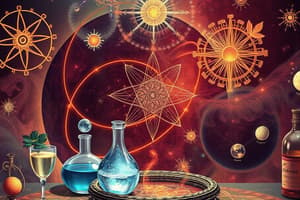Podcast
Questions and Answers
What is the main reason for putting a cork on the mouth of the flask?
What is the main reason for putting a cork on the mouth of the flask?
- To prevent the escape of gases produced during the reaction (correct)
- To allow for easy mixing of the solutions
- To make it easier to weigh the flask
- To prevent the solutions from mixing
Who established the foundation of chemical sciences by establishing two important laws of chemical combination?
Who established the foundation of chemical sciences by establishing two important laws of chemical combination?
- Democritus
- Dalton and Lavoisier
- John Dalton
- Antoine Lavoisier (correct)
What is the significance of weighing the flask with its contents before and after mixing the solutions?
What is the significance of weighing the flask with its contents before and after mixing the solutions?
- To measure the volume of the solutions
- To demonstrate the law of conservation of mass (correct)
- To determine the pH of the solutions
- To measure the temperature of the solutions
What is the term used by Democritus to describe the indivisible particles?
What is the term used by Democritus to describe the indivisible particles?
Who was born in a poor weaver's family in England in 1766?
Who was born in a poor weaver's family in England in 1766?
What is the main objective of mixing the solutions X and Y?
What is the main objective of mixing the solutions X and Y?
What is the term used to describe the combination of elements in a fixed proportion?
What is the term used to describe the combination of elements in a fixed proportion?
Why did scientists in the eighteenth century become interested in finding out how and why elements combine?
Why did scientists in the eighteenth century become interested in finding out how and why elements combine?
What is the atomicity of oxygen?
What is the atomicity of oxygen?
What is the ratio of hydrogen to oxygen in a water molecule?
What is the ratio of hydrogen to oxygen in a water molecule?
What is the term for a group of atoms that have a net charge on them?
What is the term for a group of atoms that have a net charge on them?
What type of element is argon?
What type of element is argon?
What is the simplest ratio of hydrogen to oxygen in a water molecule?
What is the simplest ratio of hydrogen to oxygen in a water molecule?
What is the atomicity of phosphorus?
What is the atomicity of phosphorus?
What type of compounds contain charged species?
What type of compounds contain charged species?
What is the atomicity of sulphur?
What is the atomicity of sulphur?
What is the ratio of elements in a chemical substance by mass according to the law of constant proportions?
What is the ratio of elements in a chemical substance by mass according to the law of constant proportions?
What is the main idea behind Dalton's atomic theory?
What is the main idea behind Dalton's atomic theory?
Which of the following is a postulate of Dalton's atomic theory?
Which of the following is a postulate of Dalton's atomic theory?
What is the significance of the law of constant proportions?
What is the significance of the law of constant proportions?
What is the name of the British chemist who provided the basic theory about the nature of matter?
What is the name of the British chemist who provided the basic theory about the nature of matter?
What is the result of the reaction between 5.3 g of sodium carbonate and 6 g of acetic acid?
What is the result of the reaction between 5.3 g of sodium carbonate and 6 g of acetic acid?
What is the significance of Dalton's atomic theory in the context of the law of chemical combination?
What is the significance of Dalton's atomic theory in the context of the law of chemical combination?
What is the idea behind the concept of 'atoms' in Dalton's atomic theory?
What is the idea behind the concept of 'atoms' in Dalton's atomic theory?
What is the term given to the simplest compounds made up of two different elements?
What is the term given to the simplest compounds made up of two different elements?
What is the purpose of crossovering the valencies of the combining atoms when writing the chemical formulae for compounds?
What is the purpose of crossovering the valencies of the combining atoms when writing the chemical formulae for compounds?
What is the valency of the magnesium ion in magnesium chloride?
What is the valency of the magnesium ion in magnesium chloride?
What is the formula for aluminium oxide?
What is the formula for aluminium oxide?
What is the formula for calcium oxide?
What is the formula for calcium oxide?
Why do we simplify the formula Ca2O2 to CaO?
Why do we simplify the formula Ca2O2 to CaO?
What is the formula of sodium carbonate?
What is the formula of sodium carbonate?
What is the formula of ammonium sulphate?
What is the formula of ammonium sulphate?
What is the formula unit mass of a substance?
What is the formula unit mass of a substance?
What is the formula of sodium oxide?
What is the formula of sodium oxide?
What is the formula of aluminium chloride?
What is the formula of aluminium chloride?
What is the formula of sodium sulphide?
What is the formula of sodium sulphide?
What is the formula of magnesium hydroxide?
What is the formula of magnesium hydroxide?
How is the formula unit mass of a compound calculated?
How is the formula unit mass of a compound calculated?
डालतन के परमाणु सिद्धांत का आधार क्या था?
डालतन के परमाणु सिद्धांत का आधार क्या था?
डालतन ने किसका नाम अपने सिद्धांत में उपयोग किया?
डालतन ने किसका नाम अपने सिद्धांत में उपयोग किया?
डालतन के सिद्धांत ने किस कानून की व्याख्या प्रदान की?
डालतन के सिद्धांत ने किस कानून की व्याख्या प्रदान की?
रासायनिक संयोजन के नियमों का क्या महत्व है?
रासायनिक संयोजन के नियमों का क्या महत्व है?
डालतन ने किसके द्वारा दिये गये विचार का विकास किया?
डालतन ने किसके द्वारा दिये गये विचार का विकास किया?
डालतन के परमाणु सिद्धांत के अनुसार, एक तत्व के परमाणु क्या होते हैं?
डालतन के परमाणु सिद्धांत के अनुसार, एक तत्व के परमाणु क्या होते हैं?
निश्चित अनुपात के कानून के अनुसार, एक रासायनिक संयोजन में अवयव क्या होते हैं?
निश्चित अनुपात के कानून के अनुसार, एक रासायनिक संयोजन में अवयव क्या होते हैं?
डालतन के परमाणु सिद्धांत ने किसका विरोध किया?
डालतन के परमाणु सिद्धांत ने किसका विरोध किया?
प्रस्तुत संकल्पना में ऑक्सिजन के परमाणुओं की संख्या क्या होती है?
प्रस्तुत संकल्पना में ऑक्सिजन के परमाणुओं की संख्या क्या होती है?
कार्बन के परमाणुओं की संरचना कैसी होती है?
कार्बन के परमाणुओं की संरचना कैसी होती है?
नाइट्रोजन और हाइड्रोजन के परमाणुओं की संख्या का अनुपात क्या होता है?
नाइट्रोजन और हाइड्रोजन के परमाणुओं की संख्या का अनुपात क्या होता है?
ऑक्सिजन के तीन परमाणुओं से मिलकर क्या बनता है?
ऑक्सिजन के तीन परमाणुओं से मिलकर क्या बनता है?
कौन सा तत्व सरल संरचना नहीं होती है?
कौन सा तत्व सरल संरचना नहीं होती है?
किन तत्वों के परमाणुओं की संख्या का अनुपात निश्चित होता है?
किन तत्वों के परमाणुओं की संख्या का अनुपात निश्चित होता है?
सोडियम कार्बोनेट का आणविक द्रव्यमान क्या होगा?
सोडियम कार्बोनेट का आणविक द्रव्यमान क्या होगा?
निम्नलिखित में से कौन सा सूत्र सही है?
निम्नलिखित में से कौन सा सूत्र सही है?
अमोनियम सल्फेट का आणविक द्रव्यमान क्या होगा?
अमोनियम सल्फेट का आणविक द्रव्यमान क्या होगा?
सोडियम ऑक्साइड का सूत्र क्या है?
सोडियम ऑक्साइड का सूत्र क्या है?
एलुमिनियम क्लोराइड का सूत्र क्या है?
एलुमिनियम क्लोराइड का सूत्र क्या है?
मैग्नीशियम हाइड्रॉक्साइड का सूत्र क्या है?
मैग्नीशियम हाइड्रॉक्साइड का सूत्र क्या है?
निम्नलिखित में से कौन सा सूत्र सही है?
निम्नलिखित में से कौन सा सूत्र सही है?
फॉर्मुला यूनिट मास क्या है?
फॉर्मुला यूनिट मास क्या है?
एक आयन का निगेटिवELY चार्ज किया हुआ भाग क्या कहलाता है?
एक आयन का निगेटिवELY चार्ज किया हुआ भाग क्या कहलाता है?
सोडियम क्लोराइड (NaCl) में कौन से आयन पाए जाते हैं?
सोडियम क्लोराइड (NaCl) में कौन से आयन पाए जाते हैं?
एक तत्व की संयोजक क्षमता क्या कहलाती है?
एक तत्व की संयोजक क्षमता क्या कहलाती है?
एक पॉलीएटोमिक आयन क्या होता है?
एक पॉलीएटोमिक आयन क्या होता है?
कैल्शियम ऑक्साइड में कौन से आयन पाए जाते हैं?
कैल्शियम ऑक्साइड में कौन से आयन पाए जाते हैं?
एक Element की संयोजक क्षमता क्या होती है?
एक Element की संयोजक क्षमता क्या होती है?
एक यौगिक में तत्वों का अनुपात क्या होता है?
एक यौगिक में तत्वों का अनुपात क्या होता है?
एक पॉलीएटोमिक आयन का उदाहरण क्या है?
एक पॉलीएटोमिक आयन का उदाहरण क्या है?
आण्विक द्रव्यमान इकाई किस प्रकार परिभाषित की गई है?
आण्विक द्रव्यमान इकाई किस प्रकार परिभाषित की गई है?
वैज्ञानिकों ने प्रारंभ में आण्विक द्रव्यमान इकाई के रूप में किसका चयन किया था?
वैज्ञानिकों ने प्रारंभ में आण्विक द्रव्यमान इकाई के रूप में किसका चयन किया था?
कार्बन-12 आइसोटोप के द्रव्यमान का 1/12वां हिस्सा क्या है?
कार्बन-12 आइसोटोप के द्रव्यमान का 1/12वां हिस्सा क्या है?
आक्सीजन परमाणु का द्रव्यमान किस वजह से महत्त्वपूर्ण माना गया था?
आक्सीजन परमाणु का द्रव्यमान किस वजह से महत्त्वपूर्ण माना गया था?
फल विक्रेता के उदाहरण में 12 फ्रूट मास यूनिट (फीएमयू) क्या हैं?
फल विक्रेता के उदाहरण में 12 फ्रूट मास यूनिट (फीएमयू) क्या हैं?
आण्विक द्रव्यमान इकाई क्या है?
आण्विक द्रव्यमान इकाई क्या है?
वैज्ञानिकों ने 1961 में क्या चुना था?
वैज्ञानिकों ने 1961 में क्या चुना था?
परमाणु क्या हैं?
परमाणु क्या हैं?
Flashcards are hidden until you start studying
Study Notes
Atoms and Chemical Combination
- Democritus introduced the concept of indivisible particles called atoms, which was later developed by scientists through experimentation and philosophical considerations.
- By the end of the 18th century, scientists recognized the difference between elements and compounds and sought to understand how and why elements combine.
Laws of Chemical Combination
- Antoine Lavoisier established two important laws of chemical combination:
- Law of Conservation of Mass: Matter cannot be created or destroyed in a chemical reaction.
- Law of Definite Proportions: In a chemical substance, elements are always present in definite proportions by mass.
Dalton's Atomic Theory
- John Dalton proposed an atomic theory based on the laws of chemical combination, which stated that:
- Atoms are indivisible particles that make up matter.
- Atoms of a given element are identical in mass and chemical properties.
- Atoms of different elements have different masses and chemical properties.
- Atoms combine in small whole number ratios to form compounds.
- The relative number and kinds of atoms are constant in a given compound.
Atomicity of Elements
- The atomicity of some elements is shown in Table 3.3, which indicates the type of element, its atomicity, and atomic mass.
Ions and Compounds
- Ions are charged species that can be positively or negatively charged, consisting of a single charged atom or a group of atoms with a net charge.
- Compounds composed of metals and non-metals contain ions, where the positive and negative charges must balance each other and the overall structure must be neutral.
- Examples of formulae for simple compounds include hydrogen chloride (HCl), aluminium oxide (Al2O3), and sodium carbonate (Na2CO3).
Formula Unit Mass
- The formula unit mass of a substance is the sum of the atomic masses of all atoms in a formula unit of a compound.
- Formula unit mass is calculated in the same manner as molecular mass.
Writing Chemical Formulae
- When writing chemical formulae, the constituent elements and their valencies are written, and then the valencies are crossed over to form the compound.
- Examples of writing chemical formulae include hydrogen chloride, hydrogen sulphide, and sodium carbonate.
Laws of Chemical Combination
- The law of constant proportions states that elements in a chemical substance are always present in definite proportions by mass, regardless of the method or source of obtaining the substance.
- Atoms of a given element are identical in mass and chemical properties.
- Atoms of different elements have different masses and chemical properties.
- Atoms combine in the ratio of small whole numbers to form compounds.
Dalton's Atomic Theory
- Dalton's theory provided an explanation for the law of constant proportions.
- The theory states that the smallest particles of matter are atoms, which are indivisible and indestructible.
- Atoms of different elements have different masses and chemical properties.
Atomic Mass Unit
- The atomic mass unit (amu) is a standard unit of mass used to express the mass of an atom.
- Initially, the amu was defined as 1/16 of the mass of an atom of naturally occurring oxygen.
- Later, the amu was redefined as one-twelfth the mass of an atom of carbon-12.
- The relative atomic masses of all elements are found with respect to an atom of carbon-12.
Atomicity of Elements
- Metals and some other elements, such as carbon, do not have a simple structure but consist of a large and indefinite number of atoms bonded together.
- Non-metals, such as oxygen, nitrogen, and chlorine, have a definite atomicity.
Molecules and Ions
- Atoms of different elements join together in definite proportions to form molecules of compounds.
- A group of atoms carrying a charge is known as a polyatomic ion.
- Ions can be positively charged (cations) or negatively charged (anions).
- The combining power (or capacity) of an element is known as its valency.
Formulae of Compounds
- Formulae of compounds represent the ratio of atoms of different elements in the compound.
- Examples of formulae of compounds include H2O, CO2, NaCl, and Na2CO3.
Molecular Mass and Formula Unit Mass
- Molecular mass is the sum of the atomic masses of all atoms in a molecule.
- Formula unit mass is the sum of the atomic masses of all atoms in a formula unit of a compound.
- Molecular mass and formula unit mass are calculated in the same manner.
Studying That Suits You
Use AI to generate personalized quizzes and flashcards to suit your learning preferences.




